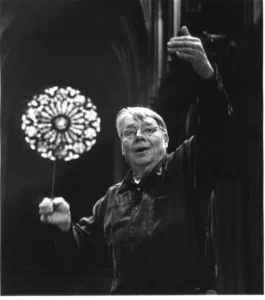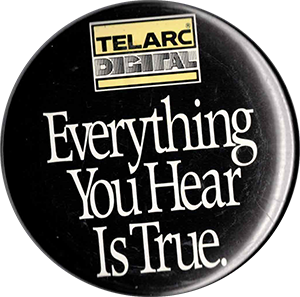Robert Shaw and the Atlanta Symphony

Conductor Robert Shaw is a fixture in the Telarc catalog, and his relationship with Telarc founders Robert Woods and Jack Renner was pivotal to Telarc’s success. Shaw’s fifty-nine recordings on the label have garnered ten Grammy awards, and one disc was immortalized in the Library of Congress National Recording Registry. By the time he first recorded for Telarc in 1978, Shaw was already known world-wide as a masterful conductor of choral music. For his first Atlanta Symphony recording with Telarc, though, he chose to begin with Stravinsky’s Firebird Suite, an all-orchestral work.1 According to Shaw’s successor, conductor Robert Spano:
Shaw also led other ensembles on the Telarc label. The Robert Shaw Chamber Singers were based in Atlanta, and the Robert Shaw Festival Singers came to his summer choral intensives in southern France. Telarc sometimes re-recorded repertoire from his already extensive discography. Perhaps Shaw had a new interpretation of a work, or perhaps it fit especially well with a particular project. In any case, each project started with in-depth discussions about what to record when, and with whom.3 Shaw had a high level of trust in the Telarc production team. Unlike most recording artists, Shaw stopped listening to playbacks during recording sessions, preferring instead to rely on the Telarc team to decide on the final product.4 He was also awarded his own personal editing mark in the Telarc project scores: in addition to the usual “I” for intonation issues, “E” for ensemble, and “N” for noise, producers would mark “RS” in the session score when Shaw made one of his characteristic guttural sounds that would need to be edited out.5
Robert Shaw was featured on the PBS series American Masters in 2019 with a showing of the film “Robert Shaw – Man of Many Voices.” Among those close to Shaw who were interviewed for this film was Telarc producer Robert Woods. Shaw also recorded extensively in his days before Telarc, including his tenure as an assistant conductor with the Cleveland Orchestra. His total discography runs over 120 albums.
Classical music, and choral music in particular, benefits from a fairly reverberant, or “wet,” acoustic environment that allows the sounds of the individual members to blend into a pleasing whole. Atlanta’s Symphony Hall at the Woodruff Arts Center proved to be too dry for Telarc’s recording style, so an orchestra board member donated dozens of sheets of plywood to be placed over the padded seats to reflect additional sound to the hall and the microphones. The plywood was carefully stored and used each time Telarc recorded the orchestra. The Telarc team also brought acoustic diffusion panels to Atlanta Symphony sessions to focus the lower string section sound towards the microphones.
Telarc continued to record the Atlanta Symphony after Shaw’s 1988 retirement from the position of Music Director. His successors, Yoel Levi, Robert Spano, and Donald Runnicles recorded another twenty-five projects. Of special note, Spano brought to the label his passion for contemporary composers, conducting award-winning recordings of the works of Jennifer Higdon, David Del Tredici, and Christopher Theofanidis.
Last updated on January 31st, 2025 at 04:12 pm
- This recording is still used as a test of playback systems and control rooms in the present day. See this document for suggestions on what to listen for. ↩︎
- Interview with Robert Spano, Robert Shaw: Man of Many Voices (film), 2019. ↩︎
- The “Robert Shaw” binder largely consists of repertoire and project ideas, along with photocopies of many (or all) of Shaw’s earlier recordings for other labels. Woods/Martone private collection, Shaker Heights, OH. ↩︎
- Keith C. Burris, Deep River: The Life and Music of Robert Shaw (Chicago: GIA Publications, 2013), 341 ↩︎
- Personal recollection of the author, who had to edit out several such sounds in Shaw projects. ↩︎
